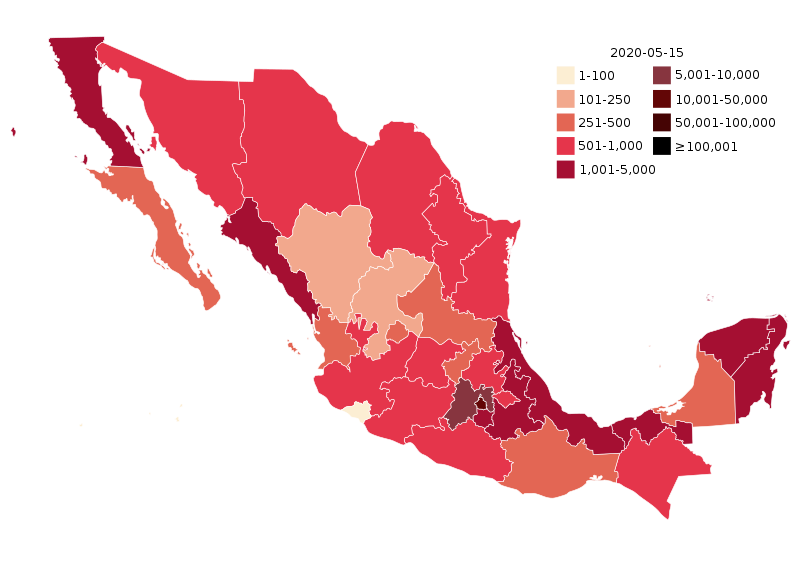Mexico is in the most critical stage of the Coronavirus pandemic. As of 18 May, the government reports 49,219 infected and 5,177 dead. The rising curve has flattened but has also lengthened. Mexico City is the epicentre of the epidemic (with 12,456 infected and 1,197 dead). It is followed by areas such as the State of Mexico, Baja California, Tabasco, Sinaloa and Veracruz.
At the start of the pandemic, President Andrés Manuel López Obrador (AMLO) continued his tours of within the country and called for people to continue leaving their homes so as not to harm the economy. However, the exponential growth of the virus in the United States alerted the Mexican government. Therefore, the strategy was significantly changed, and the government began sending planes to China for medical supplies. To date, they have sent six jets, and after a call between President López Obrador with President Trump, the United States promised to sell 1,000 respirators to Mexico. Undoubtedly, one of the most critical agreements AMLO has made to treat the pandemic is the deal made with private hospitals. This collaboration implies that 127 hospitals in the country will lend 50 per cent of their beds from 23 April to 23 May.
On the other hand, of the OECD member countries, Mexico is the one with the lowest per capita level of Covid 19 testing. Regarding this, Hugo López Gatell, the chief of staff for managing communication and health strategy, explained that the Mexican government follows the so-called ‘sentinel’ statistical model, which involves widespread monitoring and that, in itself, the number of tests is not associated with the efficiency of epidemiological treatment. How the federal government has handled the technical aspect of the pandemic has been challenged by governors of opposition political parties such as Jalisco and Nuevo León, who argue the need for more tests, and have even bought testing kits abroad.
Unlike many of the large economies, Mexico has not opted for compulsory confinement and economic activity, after two decrees (phase 2, and then phase 3, declared on 21 April) has gradually been paralyzed. The federal government issues decrees which establish the stages reached, while the states, as well as the municipalities, adopt different measures to address them. In some states, citizens and businesses that remain open are fined, while in the capital no coercive measures have been adopted. However, there is a paralysis of mobility. The passenger numbers of the subway have dropped to 70 per cent of normal levels.
The decline in the Mexican economy is frankly worrying. The central bank and international organizations speak of a GDP recession of between 5 and 7 per cent for 2020, something unprecedented in Mexico in at least 100 years. The reasons for this are that the country has a very open economy and that it was already performing poorly. These are both exogenous and endogenous reasons which depress the Mexican economy.
Exogenous reasons:
- Drop in the price of oil. Although the government has insurance coverage for any loss of revenue, the price affects the value of the Mexican peso (before the pandemic the value of the dollar was 19 pesos per dollar. The exchange rate today is 23.65 pesos per US).
- Fall in migrant remittances. Mexican migrants working in the United States make their country the third-largest recipient of remittances worldwide. In 2019, US$36,048 million entered the country, which represented 3 per cent of national GDP. These resources are essential for vulnerable states like Michoacán and Oaxaca, which have high poverty rates. A drop of 17 per cent in these revenues is expected.
- Tourism. Another industry that will be significantly affected is tourism. Mexico is the seventh most visited country in the world and the tourist expenditure represents 10 per cent of national GDP. This year this sector is expected to collapse by 46 per cent.
- Fall in exports to the United States. In 2019, bilateral trade reached a record figure of US$614.5 billion. Mexico and the United States are each other’s No.1 commercial partner. In March, exports decreased by 1.6 per cent. The closure of plants that feed value chains between Mexico, the United States and Canada is expected to affect the production of electronic and manufacturing goods in the most dynamic region on the planet.
Endogenous reasons:
- Capital flight. From March 6 to April 6, Banco de México reported the outflow of US$7, 683 million dollars from the country. Moreover, until 15 May, foreign investors withdrew US$92,800 million dollars from the portfolio investment.
- Employment crisis. Without a doubt, the Covid-19 crisis will have severe consequences for millions of jobs around the world. Since March, the Mexican Social Security Institute reported that 555,247 formal jobs have been lost. The Spanish bank BBVA stated that more than a million jobs could be lost in Mexico.
- Collapse in consumption. The country’s internal market is expected to decrease by 12 per cent this year (compared with 6 per cent in the 2009 crisis).
- Falling private investment (foreign and domestic). BBVA reports that a 20.8 per cent decrease is expected.
AMLO’s government started to gradually reopen the market activity on 17 May in the places where the pandemic has been least felt, and from 1 June in the primary areas of contagion. The Mexican economy, being closely linked with that of the United States, some companies are expected to open earlier so that they can begin to produce vital components of value chains. The rhetoric of both the AMLO government and the Trump administration is that the UMCA (United States, Mexico and Canada Agreement) that will come into force on July 1 (replacing the current NAFTA) is a lever to overcome the economic crisis.
The measures taken by AMLO to counter the effects of the economic crisis have been widely criticized for being too reductionist, aimed neither at avoiding an employment crisis, nor rescuing the middle class. Instead, the government has opted for extreme austerity measures such as cutting government wages and abolishing undersecretary posts. The government has announced the following measures:

- The implementation of a credit program that accounts for between 1.5 per cent and 2 per cent of GDP. This entails US$1,000 million for the informal economy and an equal amount for the formal economy. In addition to US$2,000 million for the rehabilitation of cities.
- Construction work will continue as planned with the government’s landmark infrastructure projects: the Santa Lucía airport, the Tren Maya and the Dos Bocas refinery.
- The plan does not include fiscal stimuli, nor postponement of payment of tax, water, or electricity bills. There is also no support for payroll payments (furloughing).
- AMLO’s key social programs aimed at some 22 million people (elderly, young with scholarships, peasants) are reinforced and maintained. The criticism is that this population does not include the 56 per cent of the Mexican working population that works in the informal sector, the population most affected by the lockdown.
- The government does not intend to acquire debt to finance the crisis. AMLO argues that debt in Mexico has historically been used to rescue elites.
Viridiana Ríos, a Mexican analyst and Harvard academic, explains that AMLO refuses to incur debt because it would reduce his scope for political maneuvre. In his view, debt makes Mexico subservient and ties its hands in dealings with powerful investors and international banks. However, she stresses that public debt can help poor people and be repaid by reducing public expenditure once the economy improves. Ríos explains that the government could support big companies under the condition that employment is maintained, tax evasion mechanisms removed, and wages raised.
Finally, the economic stagnation, the constant tension with the business class, the security crisis, and the sensation of improvised public policies have all hit AMLO’s popularity. The data offered by Roy Campos explains that in the first week of January, the approval of the President was at 58.7 per cent; today it is 44.5 per cent.
Main image: infographic from Wikipedia. Data of 17 May 2020
Armando Van Rankin Anaya is a masters student at the University of Sussex

